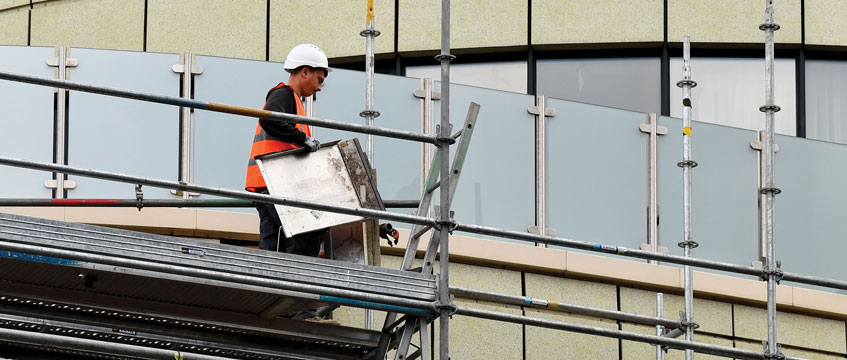COMMENT The government is clear that it expects developers to bear the brunt of recladding costs. To that end, on 14 February, Michael Gove unveiled a series of amendments to the Building Safety Bill. Included in these was the ability to create building industry schemes targeting eligible developers (likely to be those with profits of more than £10m), which will be required to contribute towards the cost of remediating faulty cladding.
To back this up, regulations will give the secretary of state the power to prevent developers which fail to effectively contribute towards that remediation (“prescribed persons”) from carrying out certain development or securing necessary building control approvals. The government was explicit in its motivation, stating: “for those in the industry not doing the right thing, the government will be able to block planning permission and building control sign-off on developments, effectively preventing them from building and selling new homes”. The message is clearly, pay – or we will hit your business.
On 4 April, the House of Lords concluded its final review stage of the draft bill with only minor changes made to Gove’s proposals, including clarification that prescribed persons are to include both those which are members of the relevant “scheme”, as well as those eligible but are not yet members. This sends a further strong message that the government is determined to ensure such powers can be used against any developers not seen to be playing their part in either carrying out or funding necessary cladding repairs.
While the government has stated that it hopes it will not need to invoke these powers, if passed, the secretary of state will be empowered to take some drastic and arguably draconian measures. The ability to prevent prescribed persons from “carrying out development” in any given case can be used to achieve two very broad purposes: “securing the safety of people in or around buildings in relation to risks arising from buildings”; and “improving the standard of buildings”. Such a wide scope creates considerable opportunities for these powers to be used. The draft legislation provides scant detail about how these powers would be enacted or applied, leaving the details to be set out in the proposed regulations.
Areas for concern
Ultimately, the proposed powers would prevent development under existing planning permissions and almost certainly those relating to applications made but not yet determined. The building control powers could prevent developments which were already under way from being occupied through the holding back of necessary approvals.
It is clear decisive action is required to address the dangers associated with unsafe cladding. However, there are some obvious areas for concern about these punitive powers, including:
- Will there be avenues to appeal or challenge a decision to prevent development, or withhold building control approvals, and would the regulations include for recovery of losses or other compensation? Compensation for revoking existing planning permissions is already well established, and this has generally had the effect of reducing the number of times permissions are revoked. However, given the coercive intentions behind the measures, it seems unlikely that compensation will be available.
- How would any imposed restrictions come to an end? To avoid long-term sterilisation of development sites, there must be a clear mechanism to unlock them – presumably this will be linked to the payment of an appropriate “contribution” or action associated with the relevant building industry scheme.
- What effect will preventing development have on the statutory period for implementing the planning permission? There is a genuine risk that hard-won planning permissions will be lost because of an inability to get onsite – something which runs counter to the vast majority of government messaging around encouraging developers and the delivery of housing.
- What comfort, if any, will investors, funders, or potential tenants require that there will be no bar to a development proceeding, or that the necessary building controls approval will be released to enable beneficial occupation?
The government had set a deadline of 5 April targeting 53 of the major housebuilders to formally commit to bear the costs of cladding repairs for all 11-18m-high buildings they had constructed in the last 30 years. Around five of the top 10 firms have pledged this commitment, with others still considering their position.
While the government has welcomed those developers who have signed up to the pledge, it reiterated that it has the “powers to impose a solution in law if those in scope do not do the same”. It is clear that the government remains determined to maintain the threat of using the powers set out in the bill to further persuade developers to step up and dig deeper.
Uncertainty and pressure remains
Given the lack of detail and the broad way in which the secretary of state may choose to apply the powers, considerable uncertainty remains for developers that have already shown considerable commitment towards funding remediation of existing developments. This is on top of the 4% residential property developer tax, which came into effect from 1 April. There appears to be a real risk that the use of these powers, or even the threat of their use, could lead to a reduction in housing delivery because of the additional uncertainty the measures introduce.
And what of the reputation of the UK’s development industry? Not only does this uncertainty risk being a deterrent to those choosing where to invest – it also shows the government is willing to take away developers’ existing rights to suit its wider agenda. At this stage, the full ramifications of this shift are yet to be revealed.
Robert Gowing is a senior associate at Hogan Lovells








